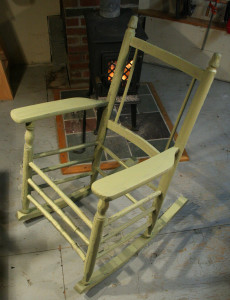Last year we took home from our off-season week in Maine a cast-off rocking chair left out on the roadside. It was a nice design, and although it needed some repair, we thought it could still serve and would remind us of the seacoast whenever we used it. All it needed was a tightening up of the joints, a new cane seat, and seatback. I have finished work on the chair, and it came out nicely, but if I ever see a chair like this on the side of the road again I will reduce it to kindling to save somebody the effort of restoring it. By my calculation, the cost at today’s labor prices to restore this chair ran to $543, which I have adjusted downwards a penny to commercialize things. Labor – disassemble, refit and reglue all joints, paint frame – 8 hours. Cane seat and seatback – 12 hours. Labor cost $25 / hour. Cane $33 plus $10 shipping. Did not charge for the glycerin added to the soak water, but it cost $6.21, if you are going to do this yourself. How did I do it?
I have never woven this type of cane before, so I took pictures before stripping off the old cane. Good idea. While I was not able to exactly duplicate the weave, the pictures were helpful. Now that I am done however, I have deleted all my pictures aside from the one below, because, as I have said, I will never be doing this again.
 The old frame was an interesting rose color that I would have kept if I had any paint that shade, but what we had was a light flat green that worked too – you can see in the picture above how the joint of the upper cross rail of the seatback was repaired with screws and the screw heads puttied over – fixing this was part of the frame reassembly job. Below is the frame reassembled with the primer coat of green paint –
The old frame was an interesting rose color that I would have kept if I had any paint that shade, but what we had was a light flat green that worked too – you can see in the picture above how the joint of the upper cross rail of the seatback was repaired with screws and the screw heads puttied over – fixing this was part of the frame reassembly job. Below is the frame reassembled with the primer coat of green paint –
And that is the way it sat for the next six months while I waited for enthusiasm to develop for caning.
My previous caning experience is mostly with machine-woven cane sold by the foot which is secured with a spline set in a groove running around the periphery of the seat / seatback, as in canoe seats. This is fairly easy to work and relatively simple and quick. One boat that I built with traditional methods has seats that I wove from single-strand cane, using the 7-step method, a method that I came to think of as the 7,000 step method. Sure there’s seven steps, you just repeat each one ad nauseam. I learned this method from a brochure published by the Extension Service at Cornell University.
I again sought directions from Cornell for the rocker and found another caning guide called Splint Seats for Chairs. (available free on-line for download now – the 7-step guide was only available on paper for $2.95 when I did the boat project) I could follow the directions more or less. The difficulties in order of irritation are:
A) dealing with short strands of cane – the bundle of cane I got trademarked MasterWeave Grade A made in China (where else?) had many strands less than 3 feet. Joining strands wastes cane because the strands have to overlap, and takes time. Towards the end if I found a strand more than 4 feet long I started to think ‘Boy, somebody is going to lose their job when the Boss finds out they let some long cane go out.’
B) dealing with poor quality cane because it breaks and produces short strands leading to irritation A.
C)not being a process-oriented individual. Caning is nothing but a process. If you are goal-oriented, time passes way too slowly for the goal to even come in sight much less present the prospect of satisfaction. You progress at the rate of about 2” per hour. Mid-job my wife reminded me that caning is an activity one might find in an insane asylum – I wondered – cause or therapy? Caning has none of the characteristics that are inherently pleasurable in their own right. Work position is awkward, forever turning the seat up, the seat down; there is ever-present risk of breaking a strand leading to re-work so you can’t really let your mind wander, but there is nothing interesting about the work either. I found myself saying ‘over under over under’ mechanically independent of how I was actually weaving the cane – sort of just to keep time.
The only thing that got interesting was waiting to see if I ran out of cane before I finished. I started with a hank of 500′ (6mm binding cane). It comes rolled up in a neat donut which I immediately turned into a rats nest of tangles by removing the ties securing the bundle, assuming it would unravel in nice tidy strands. Not so. It formed something that resembeled a large tumbleweed from which I had to carefully tease out pieces to work with. It seemed at the start to be more than enough, but as I progressed it became clear that it would be touch-and-go. I sincerely hoped that I had enough because if I had to buy more, that would commit me to more caning projects. In a flush of activity I finished the seat with literally two feet of cane left over. I threw away the Cornell pamphlet; I’ll keep my glycerin (useful for machine woven cane which I will still use), but I hope to never meet single-strand cane again. Maybe in a year or so? PS I’ll take an even $500 for the chair.

